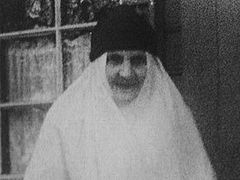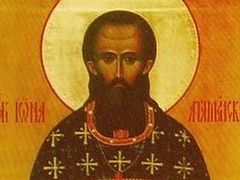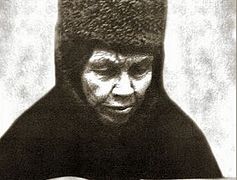Two years ago the blessed elder Paul of Taganrog was recognized as a saint for the universal veneration by the Russian Orthodox Church. By his life he set a shining example of holiness in the world, and in him the Rostov region [formerly called the Don territory, which derived its name from the River Don that flows through this region of S Russia] found its heavenly patron. June 20 was the anniversary of his earlier canonization as a locally venerated saint.
A holy stranger
Paul (Pavel) Stazhkov was born on November 21, 1792, and was named in honor of the Holy Hierarch Paul, the Patriarch of Constantinople and Confessor, who is commemorated on November 19. The boy’s parents, Paul and Parasceva Stozhkov, were wealthy noble people from the Krolevets district of the Chernigov province (now in Ukraine) and had a large number of serfs. It is evident that they were pious people too. However, they wanted their son Paul (as well as his elder brother) to get a good education and to live comfortably. However the blessed man used to say, “From my early youth my greatest desire was to pray to God and my firm resolve was to travel to holy places.”
At the early age of sixteen he left the parental home, went on a pilgrimage and led the life of a wanderer for a whole year. When he returned home, his father punished him and forbad him to go on pilgrimages to holy places any more. Afterwards the saint used to say that his father did not share his aspirations yet he was unable to change them. When Paul turned twenty-five, his father gave him his share of inheritance, allowed him to use his own discretion and let him go.
The first thing that Paul did was to give freedom to all of his peasants and to distribute the money left after selling the property among the poor. Thereafter he managed to realize his dream—to go on a long pilgrimage to holy sites.
It is known that that pilgrimage of the Blessed Paul lasted ten years. Over that time he visited a great many holy monasteries and made considerable donations to all of them. He particularly loved the Solovki Monastery, the Kiev Caves Lavra, and the Pochaev Lavra (he would visit them again afterwards). This is what he used to say about Pochaev: “He who visits Kiev but passes by Pochaev doesn’t really visit Kiev.”
A second home
At the age of thirty-five, Paul arrived at the city of Taganrog and remained there the rest of his life. He found temporary shelter in the homes of many people. But his last abode was an apartment at Depaldovsky (now Turgenevsky) Lane, where he had a cell and rented a whole little house. The blessed man wore simple peasant clothes and spoke the Malo-Russian dialect[1], so nobody could guess that he was of a noble origin.
A man of great physical strength, St. Paul would hire himself out to day work and labor, not sparing himself. But as soon as church bells began to ring, the saint would immediately put his work aside and hurry towards the church, and he never skipped church services. His favorite church was the Holy Dormition Cathedral, for which he obtained a large number of icons, icon lamps and made a number of donations. Paul used to light icon lamps and clean the icons himself; he always took a small bench and a white towel with him. According to tradition, when new side-altars were being added to the cathedral (then Paul was in an advanced old age), the man of God would carry heavy bricks up unaided, thus inspiring many by his example.
Once during the Great Entrance at the Liturgy, the dean of the cathedral (who always held the Blessed Paul in respect) saw him in white glittering garments as if he were a bishop. From that day on he held Paul in very high esteem. However, not all the cathedral clergy loved the saint; there were some ill wishers among them.
Following his retirement the elder used to drop in at the local market after services. He would always walk with a stick in his hand along with two canvas bags on his back. Traders would pressure him into coming and if he came they knew that their earnings were guaranteed. Some gave him food as alms, but he did not always accept these gifts and sometimes drove almsgivers off with his stick to their great sorrow.
The elder’s cell and community
When the elder took up residence in a separate house, he invited some people to come and stay with him for a while and indeed a number of them remained forever. Thus, a community was gradually formed around him. The elder was quite stern, never indulgent to anybody and especially disliked disobedience. Whenever visitors came to Paul, he exposed their sins in an original manner: In the presence of an assistant (a member of his community) he would mention one or another sin as if it appealed to this assistant. The latter guiltily shrugged her shoulders and begged his pardon, whereas the visitor understood that thus his sins were being exposed—it was for the spiritual benefit of his visit.
Being entirely focused on his inner life, St. Paul attached no importance to cleanness in his cell. He blessed his female assistants (from the community) to tidy up his cell only once a week, namely on Saturdays. He asked them to collect garbage into sacks which were left inside his cell for three days and then burned down. He did not allow then to throw the garbage away. The elder would sleep on a narrow bench without covering it with anything and he lay some item of his clothing under his head instead of a pillow. He slept very little and valued night prayers.
The walls of the elder’s cell were covered with icons, with icon lamps burning by each of them permanently. Sand-filled basins with numerous burning candles in them stood on benches near other icons. In addition, there were always many baskets and bags full of supplies of different kinds of food that the saint would distribute among poor visitors.
The Blessed Paul was particularly generous to prisoners. He would weekly send various foodstuffs to the prison, inquire after sick inmates’ health, and help them a great deal. Whenever any of the prisoners died, the elder would buy a coffin, clothing and all other things necessary for burial. Thanks to his loving care no inmate was denied Christian burial.
Having developed a love for pilgrimage (as an ascetic labor) in his youth, St. Paul continued this activity in mature age. He usually took several female disciples with him and they went on pilgrimages to venerate the holy shrines together. The elder attached great importance to all the hardships and trials that were unavoidable during the journey. When the saint grew old and couldn’t go on such pilgrimages, he gave his blessing to some of his female disciples to go without him, helping them in an invisible way through their journeys.
His miracles and prophecies
The Almighty bestowed numerous gifts of the Holy Spirit upon the elder Paul of Taganrog, or “Pavlo Pavlovich”, as many of his contemporaries called him. He possessed the gift of clairvoyance, and many of his prophecies were fulfilled afterwards. Once the Blessed Paul predicted to Hieromonk Damian (Kasatos) that he would become “a great figure”, implying the highest possible rank, because many years later he became the Patriarch of Jerusalem (Damian I: 1848-1931; Patriarch of Jerusalem from 1897).
When a young woman named Maria Velichko, who wanted to get married, came to the elder to ask for his blessing, she heard a totally unexpected answer: “Oh, girl, you will even die in my house!” And indeed she lived at the elder’s for the rest of her life—first as his disciple, and, after his death, as the head of his community. Eventually she became a celebrated eldress herself!
One man who wanted to become a monk came to the blessed elder to ask for his blessing. But St. Paul told him to get on the stove[2] and sit there for a while! Thus the young man stayed on the hot stove for twelve days on end. Having performed this unusual obedience successfully, he was blessed by the elder and joined a monastery. Subsequently he became a good monk on Mt. Athos where he lived until his death.
The elder healed many people from various diseases, when doctors were often absolutely helpless. In many cases healing occurred as soon as Blessed Paul beat a sick person in his sore spot with his stick.
One man whose wife was dying at home heard about the blessed wonderworker and came to him from far off as his “last resort”. But as soon as the man appeared on the saint’s doorstep, the latter hit him on his head with his stick and said: “Why are you here? Go back home! Your wife has cooked a lot of vareniki [a traditional Russian dish: dumplings with curd, vegetable or berry filling.—Trans.] for you!” Dumbfounded, the man went home without understanding what had happened. When he got back home, he (much to his amazement) found his wife healthy and on her feet—she had just cooked a bowl of dumplings for his arrival! It turned out that the healing had taken place exactly when the elder struck the man’s head with his stick.
And there were countless such extraordinary stories and miracles!
The repose and canonization of the blessed elder
St. Paul’s life on earth was coming to an end. It is known that shortly before his repose the elder was visited by St. John of Kronstadt. According to tradition, St. John greeted him with the words: “Rejoice, O pillar from earth to heaven!” In his turn, the elder replied: “Rejoice, O sun from the west to the east!”
The Blessed Paul passed away on March 23, 1879, soon after he had received his last Communion. At the night when our saint departed to God, a well-known archpriest in Taganrog, who had no special liking for St. Paul during his lifetime, saw angels carrying someone’s holy soul to heaven and singing celestial hymns. He asked whose soul it was and got the answer: “This is the soul of Pavlo Pavlovich.” Thereupon he regretted having previously disliked the righteous man.
The repose of the blessed elder was accompanied by one more miracle. When God took his holy soul, many saw a sallow shadow go through his body and vanish: at the same moment his whole body became snow-white, and his face was shining with joy.
The elder predicted that there would be swarms of flies on the day of his burial. He implied that multitudes of people would come to bid farewell to the beloved elder, and they were indeed as numerous “as flies”. There were so many of the faithful during the funeral that they had to queue for several hours to come up to St. Paul’s coffin and bid farewell to him. Quite a few miracles happened as well.
The Blessed Paul was widely venerated during his lifetime and his veneration spread after his repose. It was the fulfilment of another prophecy of the holy elder: “Though I will die, my place won’t stand empty.” Both his grave and his cell (the latter is still extant and receives pilgrims) became destinations for pilgrimages after his repose. Through the efforts and donations of those who loved and venerated the elder a chapel was erected at the cemetery.
The long-awaited canonization of the Blessed Paul for local veneration took place on June 20, 1999. On that day his precious relics were solemnly translated into the St. Nicholas Church of Taganrog. “Paul was carried to the grave, and from there straight into the cathedral,” the elder used to hum these words not long before his demise. The canonization of the blessed man was accompanied by also some miracles: On a fine day a rainbow appeared around the sun; later, clouds in the sky formed into the shape of a cross above the site where the festive events had taken place. The Church-wide veneration of the Blessed Paul of Taganrog was approved in 2016.
Instructions of St. Paul of Taganrog
The holy elder would give much spiritual advice to those who came to him; some of his instructions survive to this day. It is known that he attached special importance to good works and acts of charity, particularly those related to the decoration of churches. He exhorted all believers to keep a sufficient quantity of lamp oil, candles and frankincense at their homes so that at least one icon lamp could perpetually burn in front of icons. He taught people to observe Church feasts and Sundays; he also personally observed Friday[3] and recommended people to put vain work aside on this day. The saint valued the podvig [ascetic labor] of pilgrimage, “wandering for Christ’s sake”, which involve hardships and trials.
Below we give a few more instructions of the Blessed Paul:
- Pray hard and persistently. A bad feeling will suggest to you that your prayer is insincere and full of doubts, yet you should persevere in prayer. When you do something wrong you shouldn’t lose your heart; rather, you should pray. Who can help you in this situation? What person? None but God! And you must pray to Him without ceasing, at all times. His Truth is eternal, His power is invincible.
- Pray to God unceasingly. Seek consolation and gratification in prayer. Prefer prayer to food and sleep. The time devoted to prayer and vigil is the most grace-filled one.
- The supreme sacrifice for you is the bloodless sacrifice, offered in our churches for the forgiveness of our sins as instituted by our Lord Jesus Christ.
- Love purity of soul more than purity of body; strive for it with every fiber of your being, maintaining it unremittingly through good works, labors and prayers.
- Be a champion of Orthodoxy! This Church has stood since the times of the apostles and, despite the weaknesses of its pastors and flock, it is holy and the only bearer of Truth.
Prepared by Marina Chizhova
Translation by Dmitry Lapa








